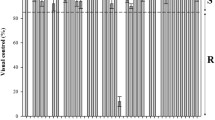Summary
Herbicide-resistant lines of birdsfoot trefoil (Lotus corniculatus L. cv ‘Leo’) were isolated after sequential selection at the callus, shoot, and whole plant levels to the sulfonylurea (SU) herbicide Harmony {DPX-M6316; 3-[[[(4-methoxy-6methyl-1,3,5, triazine-2-yl) amino] carbonyl] amino] sulfonyl-2-thiophenecarboxylate}. In field and growth chamber tests the Harmony regenerant lines displayed an increased tolerance as compared to control plants from tissue culture and controls grown from seed. Results of evaluation of callus cultures of regenerated mutant lines signify stability of the resistance. Outcrossed seeds collected from field trials, and tested in vitro for herbicide resistance, indicate that the trait is heritable and that resistance may be due to reduced sensitivity of acetolactate synthase to SU inhibition. Genetically stable herbicide-resistant lines of birdsfoot trefoil were successfully isolated using in vitro selection.
Similar content being viewed by others
References
Bingham ET, McCoy TJ (1986) Somaclonal variation in alfalfa. Plant Breed Rev 4:123–152
Blair AM, Martin TD (1988) A review of the activity, fate and mode of action of sulfonylurea herbicides. Pestic Sci 22:195–219
Brettel RD, Ingram S, Thomas S (1980) Selection of maize tissue cultures resistant to Drechslera (Helminthosporium maydis) T-Toxin. In: Ingram DS, Helgelson JP (eds) Tissue culture methods for plant pathologists. Blackwell, London, pp 233–237
Chaleff RS (1981) Genetics of higher plants: applications of cell culture. Cambridge Press, New York
Chaleff RS (1983) Isolation of agronomically useful mutants from plant cell cultures. Science 219:676–682
Chaleff RS, Mauvais CJ (1984) Acetolactate synthase is the site of action of two sulfonylurea herbicides in higher plants. Science 224:1443–1445
Chaleff RS, Ray TB (1984) Herbicide-resistant mutants from tobacco cell cultures. Science 223:1148–1151
Conger AD, Fairchild LM (1953) A quick freeze method for making smear slides permanent. Stain Technol 28:281–283
Darlington CD, La Cour LF (1976) The handling of chromosomes, 6th edn. George Allen and Unwin, London
Devine TE, Seaney RR, Linscott DL, Hagin RD, Brace N (1975) Results of breeding for tolerance to 2,4-D in birdsfoot trefoil. Crop Sci 15:721–724
Duncan DR, Widholm JM (1986) Cell selection for crop improvement. Plant Breed Rev 4:153–173
Du Pont de Namour EI (1984) Technical information bulletin on DPX-M6316 dated 2/1/84, 21 pp
Gamborg OL, Miller RA, Ojima K (1968) Nutrient requirements of suspension cultures of soybean root cells. Exp Cell Res 50:151–158
Grant WF, Marten GC (1985) Birdsfoot trefoil. In: Heath ME, Metcalfe DS, Barnes RF (eds) Forages: science of grassland agriculture, 4th edn. Iowa State University Press, Ames/IA, pp 98–108
Grant WF, Bullen MR, Nettancourt D de (1962) The cytogenetics of Lotus. I. Embryo-cultured interspecific diploid hybrids closely related to L. corniculatus. Can J Genet Cytol 4:105–128
Gressel J, Zelkah S, Ezra G (1978) Herbicide action, resistance and screening in cultures vs. plants. In: Thorpe TA (ed) Frontiers of plant tissue culture. Proc 4th Int Congr Plant Tissue Cell Cult. Int. Assoc. Plant Tissue Culture, Calgary, pp 427–436
Haughn GW, Somerville C (1986) Sulfonylurea-resistant mutants of Arabidopsis thaliana. Mol Gen Genet 204:430–434
Hoveland CS, Haaland RL, Harris RR, McGuire JA (1982) Birdsfoot trefoil in Alabama. Ala Agric Exp Stn Bull No 537
Jordan MC, McHughen A (1987) Selection for chlorsulfuron resistance in flax (Linum usitatissimum) cell cultures. J Plant Physiol 131:333–338
Knowlton S, Mazur BJ, Arntzen CJ (1988) Creation and field testing of sulfonylurea-resistant crops. In: Fraley RT, Frey NM, Schell J (eds) Genetic improvements of agriculturally important crops: progress and issues. Cold Spring Harbor Laboratory Press, Cold Spring Harbor/NY, pp 55–60
Larkin PJ, Scowcroft WR (1983) Somaclonal variation and eyespot toxin tolerance in sugarcane. Plant Cell Tiss Org Cult 2:111–121
Levitt G (1983) Sulfonylureas, new herbicides. In: Miyamoto J, Kearney PC (eds) Pesticide chemistry, human welfare and the environment. Oxford Press, New York pp 243–250
MacLean NL, Grant WF (1987) Evaluation of birdsfoot trefoil (Lotus corniculatus) regenerated plants following in vitro selection for herbicide tolerance. Can J Bot 65:1275–1280
Madill JE, Curnoe WE, MacDonald DW (1980) Successful forage establishment. Agdex Publ No. 120/22
Meredith CP (1984) Selecting better crops from cultured cells. In: Gustafson JP (ed) Gene manipulation in plant improvement. Plenum, New York, pp 503–528
Murashige T, Skoog F (1962) A revised medium for rapid growth and bioassays with tobacco tissue cultures. Physiol Plant 15:473–497
Ray TB (1984) Site of action of chlorsulfuron. Plant Physiol 75:827–831
Saari LL, Cotterman JC, Primiani MM (1990) Mechanism of sulfonylurea herbicide resistance in the broadleaf weed, Kochia scoparia. Plant Physiol 93:55–61
Saxena PK, King J (1988) Herbicide resistance in Datura innoxia. Cross-resistance of sulfonylurea-resistant cell lines to imidazolinones. Plant Physiol 86:863–867
Sebastian SA, Fader GM, Ulrich JF, Forney DR, Chaleff RS (1989) Semidominant soybean mutation for resistance to sulfonylurea herbicides. Crop Sci 29:1403–1408
Sionis SD, Drobny HG, Lefebvre P, Upstone ME (1985) DPX-6316, a new sulfonylurea cereal herbicide. Weeds 1:49–54
Stark GR, Wahl GM (1984) Gene amplification. Annu Rev Biochem 53:447–491
Swanson EB, Tomes DT (1980a) Plant regeneration from cell cultures of Lotus corniculatus L. and the selection and characterization of 2,4-D tolerant lines. Can J Bot 58:1205–1209
Swanson EB, Tomes DT (1980b) In vitro responses of tolerant and susceptible lines of Lotus corniculatus L. to 2,4-D. Crop Sci 20:792–795
Swanson EB, Coumans MP, Brown GL, Patel JD, Beversdorf WD (1988) The characterization of herbicide-tolerant plants in Brassica napus L. after in vitro selection of microspores and protoplasts. Plant Cell Rep 7:83–87
Tomes DT (1982) Selection at the cellular level in crop plants: potential for agriculture. Highlights Agric Res 5 (1):1–3
Torrey JG (1967) Morphogenesis in relation to chromosomal constitution in long-term plant tissue culture. Physiol Plant 20:265–275
Wakefield RC, Skaland N (1965) Effects of seeding rate and chemical weed control on establishment and subsequent growth of alfalfa (Medicago sativa L.) and birdsfoot trefoil (Lotus corniculatus L.). Agron J 57:547–550
Author information
Authors and Affiliations
Additional information
Communicated by H. F. Linskens
Rights and permissions
About this article
Cite this article
Pofelis, S., Le, H. & Grant, W.F. The development of sulfonylurea herbicide-resistant birdsfoot trefoil (Lotus corniculatus) plants from in vitro selection. Theoret. Appl. Genetics 83, 480–488 (1992). https://doi.org/10.1007/BF00226537
Received:
Accepted:
Issue Date:
DOI: https://doi.org/10.1007/BF00226537




